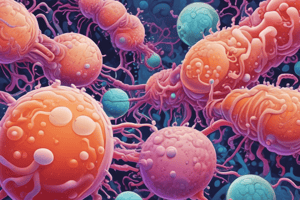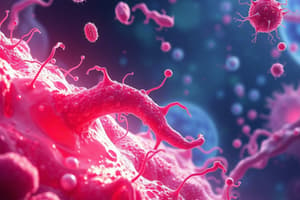Podcast
Questions and Answers
What are the characteristics of Mucoid colonies?
What are the characteristics of Mucoid colonies?
Glistening and water-like in appearance
Describe the appearance of Smooth colonies.
Describe the appearance of Smooth colonies.
Homogenous and uniform without appearing as liquid or mucoid
What is the characteristic of Rough colonies?
What is the characteristic of Rough colonies?
Appear granulated and rough
What are the types of colonies based on serologic characteristics?
What are the types of colonies based on serologic characteristics?
Solid culture media can be categorized into plated and tubed types.
Solid culture media can be categorized into plated and tubed types.
What process do bacteria use to divide?
What process do bacteria use to divide?
All cocci are gram positive except Neisseria, Branhamella, and Veilonella.
All cocci are gram positive except Neisseria, Branhamella, and Veilonella.
Which special stain is used to demonstrate the capsule of bacteria?
Which special stain is used to demonstrate the capsule of bacteria?
The _ divides bacteria by defining their shape and is mainly composed of peptidoglycan.
The _ divides bacteria by defining their shape and is mainly composed of peptidoglycan.
Match the following bacterial structures with their functions:
Match the following bacterial structures with their functions:
What process is used to stain acid-fast organisms?
What process is used to stain acid-fast organisms?
What type of movement do bacteria exhibit in liquid medium?
What type of movement do bacteria exhibit in liquid medium?
Which factors are considered virulence factors in bacteria? (Select all that apply)
Which factors are considered virulence factors in bacteria? (Select all that apply)
Exotoxins are released by __________ cells, while endotoxins are released upon lysis of cells.
Exotoxins are released by __________ cells, while endotoxins are released upon lysis of cells.
Endotoxins are mostly released by Gram-negative bacteria.
Endotoxins are mostly released by Gram-negative bacteria.
Match the following microscopy types with their descriptions:
Match the following microscopy types with their descriptions:
What are the possible sources of errors in susceptibility testing?
What are the possible sources of errors in susceptibility testing?
Increased cations like Mg++ and Ca++ can cause increased resistance of P.aeruginosa to aminoglycosides.
Increased cations like Mg++ and Ca++ can cause increased resistance of P.aeruginosa to aminoglycosides.
A positive catalase test results in the formation of _ bubbles.
A positive catalase test results in the formation of _ bubbles.
Which of the following colors is associated with Staphylococcus aureus?
Which of the following colors is associated with Staphylococcus aureus?
Match the following hemolysis types with their descriptions:
Match the following hemolysis types with their descriptions:
What is the principle behind the Decarboxylase/Dihydrolase test?
What is the principle behind the Decarboxylase/Dihydrolase test?
Which color indicates a positive result in the Citrate test?
Which color indicates a positive result in the Citrate test?
Lysine decarboxylase test is used to detect the ability of organisms to convert lysine into cadaverine.
Lysine decarboxylase test is used to detect the ability of organisms to convert lysine into cadaverine.
ONPG test is based on the utilization of _______.
ONPG test is based on the utilization of _______.
Match the molecular diagnosis technique with its description:
Match the molecular diagnosis technique with its description:
Flashcards are hidden until you start studying
Study Notes
Bacteriology: Review Notes
Characteristics of Bacteria
- Bacteria are single-cell prokaryotic microorganisms that divide by binary fission.
- They are 0.5-1 micron in size, comprising mostly water (70%), carbohydrates, proteins, lipids, and enzymes.
Gram Staining
- Gram staining is a method employed in the identification of bacteria in the laboratory.
- The method includes crystal violet, Gram's iodine, and safranin.
- Teichoic acid is present in Gram-positive bacteria, while outer membrane with lipopolysaccharides (LPS) and porins is present in Gram-negative bacteria.
Classification of Bacteria
- Prokaryotes can be classified into three groups: Eubacteria (true bacteria), Cyanobacteria (blue-green algae), and Archaebacteria (survive in extreme environments).
- Gram-positive bacteria include Bacillus, Corynebacterium, Erysipelothrix, Lactobacillus, Listeria, Mycobacterium, and Nocardia.
- Gram-negative bacteria include Acinetobacter, Aeromonas, Alcaligines, Bordetella, Brucella, Enterobacteriaacea, Francisella, Legionella, Pasteurella, Pseudomonas, and Vibrio.
Bacterial Cell Structure
- The cell wall is responsible for the shape of the bacteria and contains peptidoglycan (also known as murein layer).
- The cytoplasmic membrane is the site of energy production among prokaryotes and is selectively permeable.
- Mesosomes are points of attachment of chromosomes, while inclusions include Much's granules (lipids), Babe-Ernst granules (polyphosphates), and ribosomes.
Acid-Fast Staining
- Acid-fast staining is used to identify Mycobacterium tuberculosis.
- The Ziehl-Neelsen stain uses carbol fuchsin, acid alcohol, and methylene blue.
- Modifications of the Ziehl-Neelsen stain include the Pappenheim stain and the Baumgarten stain.
Motility
- Motility can be observed through hanging drop preparation (HDP) or wet mount.
- Methods to determine motility include HDP, SIM (Sulfide Indole Motility), staining the flagella, serological tests, swarming tests, and fluorescence tests.
Virulence Factors
- Virulence factors include adherence factors (pili or fimbriae), antiphagocytic factors (capsule), enzymes (hyaluronidase), and toxins (endotoxin or exotoxin).
Microscopy Types
- Types of microscopy include bright-field microscopy, dark-field microscopy, fluorescent microscopy, and electron microscopy.
Bacterial Growth Factors
- Bacterial growth factors include nutrients (carbon source, nitrogen source, minerals, and salts), oxygen and carbon dioxide availability, and temperature.
- Obligate aerobes require ambient air, while obligate anaerobes grow without oxygen. Facultative anaerobes can survive without oxygen, and microaerophilic bacteria require reduced oxygen.### Specimen Collection and Transport
- Specimens for bacteriology should be collected properly to prevent contamination with normal skin flora.
- Use of swabs: Cotton or Dacron/Ca alginate swabs are used for collection.
- Transport media:
- Stuart's medium: for gonococci, contains anaerobic salt solution.
- Cary and Blair medium: for V. cholerae, S. typhi, and Yersinia pestis.
- Amies medium: for Vibrio sp., contains charcoal to adsorb bactericidal/static substances.
- Glycerol saline medium: for enteric fever bacilli (Salmonella).
Culture Media
- Classification of culture media:
- According to consistency: liquid, semi-solid, and solid.
- According to composition: synthetic/defined, non-synthetic, and tissue culture media.
- Types of culture media:
- Enriched media: support the growth of fastidious organisms.
- Selective media: promote growth of desirable organisms and inhibit others.
- Differential media: distinguish between different organisms based on their characteristics.
- Special or specific media: support the growth of specific organisms.
Bacteriological Examination
- Interpretation of culture results:
- CFU/ml: number of colonies per milliliter of specimen.
- Significant bacteriuria: ≥105 CFU/ml.
- Doubtful bacteriuria: 103-105 CFU/ml.
- Possible contaminant: <103 CFU/ml.
- Types of colonies based on serologic characteristics:
- Mucoid: glistening and water-like in appearance.
- Smooth: homogenous and uniform without appearing as liquid or mucoid.
- Rough: granulated and rough.
Identification of Microorganisms
- Selective/Differential media for gram-negative enteric bacilli:
- Eosin-Methylene Blue (EMB) agar: lactose fermenters produce pink-purple colonies.
- MacConkey agar: lactose fermenters produce pink colonies.
- Hektoen Enteric Agar: lactose fermenters produce yellow colonies with black centers.
- Selective/Differential media for other microorganisms:
- Salmonella-Shigella Agar: for Salmonella and Shigella.
- Mannitol Salt Agar: for Staphylococcus sp.
- Thiosulfate Citrate Bile Salt Sucrose (TCBS) agar: for Vibrio sp.
Antimicrobial Susceptibility Testing (AST)
- Steps in performing AST:
- Inoculate Mueller Hinton agar/broth with test organism.
- Apply antibiotic discs.
- Invert and incubate at 37°C for 16-18 hours.
- Measure the zone of inhibition.
- Interpret susceptibility from the standard chart.
- Possible sources of errors in AST:
- Mixed culture
- Inoculum too light or heavy
- Improper storage of discs
- Deterioration of turbidity standard or control strains
- Reading and clerical errors
Biological Activities of Microorganisms
- Enzyme production: coagulase, catalase, etc.
- Production of hemolysin:
- α (alpha) hemolysin: incomplete or partial hemolysis.
- β (beta) hemolysin: complete hemolysis.
- γ (gamma) hemolysin: no hemolysis.
- Production of pigment in bacteria:
- Serratia marcescens: red (prodigiosin).### Bacteriology Review Notes
Pigment Production
- Chromobacterium violaceum: produces violet/purple pigment
- Pseudomonas aeruginosa: produces blue pigment (pyocyanin) and green pigment (pyoverdin)
- Pseudomonas fluorescens: produces yellow-green pigment (pyoverdin)
- Staphylococcus aureus: produces yellow-golden pigment
- Staphylococcus epidermidis: produces white pigment
- Actinomyces: produces silver pigment
- Micrococcus roseus: produces pink pigment
- Prevotella melaninogenica: produces black pigment
- Sarcina aurentiaca: produces orange pigment
Biochemical Reactions
- Catalase test: differentiates gram-positive and gram-negative organisms
- Principle: catalase breaks down hydrogen peroxide (H2O2) to oxygen (O2) and water (H2)
- Media: hydrogen peroxide (H2O2)
- Result: (+) bubble formation, (-) no bubble formation
- Coagulase test: differentiates Staphylococcus aureus from other Staphylococcus species
- Principle: coagulase breaks down fibrinogen to form a clot
- Media: plasma
- Result: (+) clot formation, (-) no clot formation
Streptococci
- Bacitracin disk test: differentiates group A beta-hemolytic Streptococci (Streptococcus pyogenes) from other beta-hemolytic Streptococci
- Principle: Streptococcus pyogenes is susceptible to low doses of bacitracin
- Media: Taxo A-Bacitracin disk
- Result: (+) zone of inhibition, (-) no zone of inhibition
- Optochin disk test: differentiates alpha-hemolytic Pneumococci (Streptococcus pneumoniae) from other alpha-hemolytic Streptococci
- Principle: Streptococcus pneumoniae is sensitive to optochin
- Media: Taxo P-Optochin disk
- Result: (+) zone of inhibition, (-) no zone of inhibition
Test for Gram-Negative Organisms
- Oxidase test: differentiates Neisseria and Pseudomonas from other gram-negative bacteria
- Principle: oxidase breaks down tetramethyl-p-phenylenediamine to form a colored complex
- Media: Kovac's reagent
- Result: (+) dark purple color, (-) no color
- Indole test: differentiates gram-negative bacteria based on their ability to split indole from tryptophan
- Principle: kovac's reagent detects the presence of indole
- Media: tryptophan broth
- Result: (+) red color, (-) no color
Carbohydrate Fermentation
- CHO (carbohydrate) fermentation test: differentiates bacteria based on their ability to ferment carbohydrates
- Principle: fermentation of simple sugars serves as the main source of energy for microorganisms
- Media: various carbohydrate media (e.g., glucose, lactose, etc.)
- Result: (+) acid production, (-) no acid production
Nitrogen Metabolism
- Methyl red test: differentiates bacteria based on their ability to produce acidic or alkaline metabolites
- Principle: methyl red indicator detects the presence of acidic metabolites
- Media: Clark and Lubbs Dextrose Broth
- Result: (+) red color, (-) yellow color
- Voges-Proskauer test: differentiates bacteria based on their ability to produce acetoin or acetylmethylcarbinol
- Principle: Voges-Proskauer reagent detects the presence of acetoin or acetylmethylcarbinol
- Media: Clark and Lubbs Dextrose Broth
- Result: (+) red color, (-) yellow color
Decarboxylase/Dihydrolase Test
- Decarboxylase test: differentiates bacteria based on their ability to decarboxylate or hydrolyze amino acids
- Principle: decarboxylase breaks down amino acids to form amines
- Media: LOA (Lysine Ornithine Arginine) medium
- Result: (+) red or purple color, (-) yellow color
Molecular Diagnosis
- Polymerase Chain Reaction (PCR): amplifies specific DNA targets
- Principle: PCR uses primers to amplify specific DNA sequences
- Media: PCR reagents and template DNA
- Result: (+) amplification of target DNA sequence, (-) no amplification
- Loop-Mediated Isothermal Amplification (LAMP): amplifies specific DNA targets
- Principle: LAMP uses a single tube technique for amplification
- Media: LAMP reagents and template DNA
- Result: (+) amplification of target DNA sequence, (-) no amplification
- MALDI-TOF (Matrix-Assisted Laser Desorption/Ionization-Time of Flight) mass spectrometry: identifies microorganisms based on their molecular mass
- Principle: MALDI-TOF uses a laser to ionize molecules, which are then separated based on their mass-to-charge ratio
- Media: MALDI-TOF matrix and sample
- Result: (+) identification of microorganism, (-) no identification
Studying That Suits You
Use AI to generate personalized quizzes and flashcards to suit your learning preferences.




